#OSIRIS-APEX
Explore tagged Tumblr posts
Text
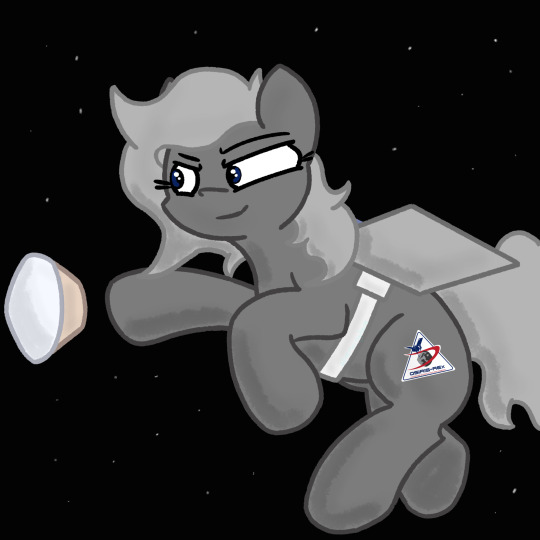
This is the exact moment OSIRIS-REx became OSIRIS-APEX
Anyways, congratulations to NASA and Lockheed Martin for successfully recovering OSIRIS-REx's sample return capsule, containing asteroid samples from Bennu! With that mission done, OSIRIS-REx is not redesignated as OSIRIS-APEX, with the new mission of exploring the near-Earth asteroid of Apophis! Safe travels OSIRIS-APEX!
----------------------------------------
Like my art? Consider supporting me on Ko-fi!
#Art#Random Art#MLP#My Little Pony#MLP Art#Space#Space Art#OSIRIS-REx#OSIRIS-APEX#NASA#Asteroids#My Little Pony Art
18 notes
·
View notes
Text
Asteroid Treasure: OSIRIS-REx returns with Bennu samples
The samples returned from asteroid Bennu are safely contained in the sample return capsule following its parachute-assisted touchdown in the Utah desert. Credit: NASA After a seven-year, 3.86-billion-mile odyssey, NASA’s OSIRIS-REx mission successfully delivered to Earth samples from asteroid Bennu. Continue reading Untitled
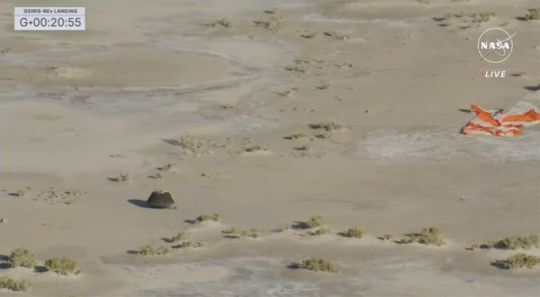
View On WordPress
4 notes
·
View notes
Text
L'asteroide Aphosis in viaggio verso la terra
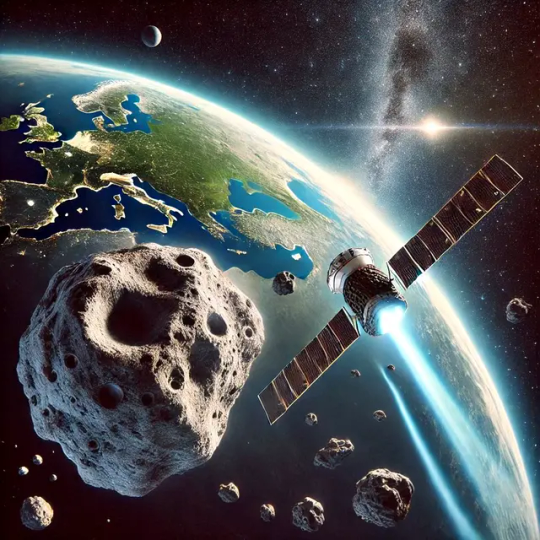
Apophis ci sfiorerà nel 2029, al punto che ne avvertiremo la forza gravitazionale. Nel 2029 l’asteroide Apophis sfiorerà la Terra, avvicinandosi più dei satelliti artificiali e perfino facendo sentire la sua gravità. L’asteroide Apophis, che prende il nome dal dio egizio Apopi, signore del caos e della distruzione, è un asteroide vicino alla Terra che ha suscitato grande attenzione a causa del suo avvicinamento al nostro pianeta. Praticamente saremo sfiorati nel 2029. Scoperto nel 2004, Apophis è classificato come oggetto potenzialmente pericoloso. Se si avvicinerà al pianeta nel 2029 come previsto, l’influenza gravitazionale sarà sufficiente a provocare scosse gravitazionali: Un recente studio guidato da Ronald-Louis Ballouz del Johns Hopkins University Applied Physics Laboratory suggerisce che l’asteroide 99942 Apophis potrebbe subire delle scosse, simili a terremoti, a causa dell’attrazione gravitazionale della Terra durante il flyby ravvicinato del 13 aprile 2029, con simulazioni che indicano cambiamenti significativi della superficie. Apophis, grande circa 340 metri, passerà a circa 32.000 chilometri dalla Terra, più vicino di molti satelliti in orbita. Quando Apophis è stato scoperto il 19 giugno 2004 da Roy Tucker, David Tholen e Fabrizio Bernardi durante la University of Hawaii Asteroid Survey (UHAS), i calcoli iniziali indicavano che avrebbe potuto avvicinarsi alla Terra con un rischio di collisione, soprattutto durante il suo passaggio nel 2029. Non ha aiutato il fatto che il suo nome derivi dal dio egizio delle tenebre e del caos.

Dimensioni dell’asteroide confrontato con due noti edifici terrestri Le stime iniziali sul rischio di collisione arrivavano al 2,7% e Apophis ha ottenuto il punteggio più alto mai raggiunto sulla “scala Torino”, un metodo utilizzato per valutare la minaccia che un asteroide rappresenta per la Terra. Tuttavia, nuovi calcoli e osservazioni hanno portato gli scienziati a concludere che non ci sarà alcun impatto…. per almeno 100 anni. ….Utilizzando i dati disponibili all’epoca, gli astronomi ritenevano che ci fosse la possibilità che il flyby potesse alterare la traiettoria di Apophis in modo da allinearlo a una collisione con la Terra nel 2068. Tuttavia, le osservazioni radar di Apophis effettuate dal Goldstone Deep Space Communications Complex della NASA in California e dal Green Bank Observatory, in West Virginia, nel marzo 2021 hanno migliorato notevolmente le nostre conoscenze sull’orbita attuale dell’asteroide e hanno permesso agli astronomi di escludere definitivamente qualsiasi possibilità di impatto con la Terra per almeno 100 anni. Anche se non colpirà la Terra, Apophis sarà abbastanza luminoso nei cieli da essere visibile a occhio nudo. Una festa per gli astronomi e gli appassionati! Come ho già detto, i gruppi di osservazione della National Aeronautics and Space Administration (NASA) stanno attualmente preparando i loro piani per osservazioni ravvicinate e personali. La missione OSIRIS-APEX è programmata per visitare l’asteroide. Essa prosegue la missione OSIRIS-REx, che ha raccolto e restituito con successo campioni dall’asteroide Bennu. OSIRIS-APEX è una missione per studiare i cambiamenti fisici dell’asteroide Apophis che deriveranno dal suo raro incontro ravvicinato con la Terra nell’aprile 2029. In quell’anno, l’orbita di Apophis lo porterà a meno di 20.000 miglia (32.000 chilometri) dalla superficie terrestre, più vicino alla Terra dei nostri satelliti più alti. L’attrazione gravitazionale del nostro pianeta dovrebbe alterare l’orbita dell’asteroide, modificarne la velocità di rotazione sul proprio asse ed eventualmente provocare scosse o frane che ne modificheranno la superficie.

OSIRIS-APEX permetterà agli scienziati sulla Terra di osservare questi cambiamenti. Inoltre, la sonda OSIRIS-APEX si immergerà verso la superficie di Apophis – un asteroide “pietroso” composto da materiale silicato (o roccioso) e da una miscela di nichel e ferro metallici – e accenderà i suoi motori per sollevare rocce e polvere. Questa manovra permetterà agli scienziati di dare un’occhiata alla composizione del materiale appena sotto la superficie dell’asteroide. Sono in corso di pianificazione anche altri progetti satellitari, tra cui quelli relativi alla difesa planetaria. Nell’ambito dell’auspicato progetto “NEAlight”, un team della Julius-Maximilians-Universität Würzburg (JMU), guidato dall’ingegnere spaziale Hakan Kayal, ha rivelato tre concetti per tali veicoli spaziali. Ognuno dei satelliti proposti avrà l’obiettivo di sfruttare questo passaggio di asteroidi perché la Terra vive un evento del genere solo una volta ogni millennio. L’obiettivo? Raccogliere dati che possano aiutare gli scienziati a comprendere meglio il sistema solare e forse anche a sviluppare misure di difesa contro gli asteroidi pericolosi. E magari predisporre piani per evitare che qualche asteoride vagante si schianti sulla Terra, facendoci fare la fine dei dinosauri. Non bisogna lasciare la caso l’estinzione dellla razza umana, dobbiamo riuscirci noi, coscientemente. Read the full article
0 notes
Photo

After NASA's epic OSIRIS-REx capsule landing success, spacecraft heads to asteroid Apophis on new mission | Space
The NASA probe that delivered precious samples of the space rock Bennu to Earth is now on an extended voyage to study an infamous near Earth asteroid.
OSIRIS-REx completed NASA's first asteroid sample return mission on Sunday (Sept. 24), when its reentry capsule landed in the western Utah desert. But now the main spacecraft has embarked on a side quest: to scope out and get up close with Apophis, an asteroid previously thought to potentially pose a threat to Earth.
The spacecraft used its return to Earth to fling itself on a course toward Apophis. It fired its engines about 20 minutes after releasing the reentry capsule containing pristine material from the early solar system, effecting a trajectory change and setting it on another long, looping voyage. ...
5 notes
·
View notes
Text
Twenty minutes after the drop-off, the spacecraft will fire its thrusters to divert past Earth toward asteroid Apophis…
Wait. Apophis?
As in 99942-Apophis, Stargate SG1 villain, enemy of Ra, Torino scale highscore champion, the Uncreator evil serpent that dwells in the eternal darkness of the Duat headed-inbound-in-2036 Apophis?!
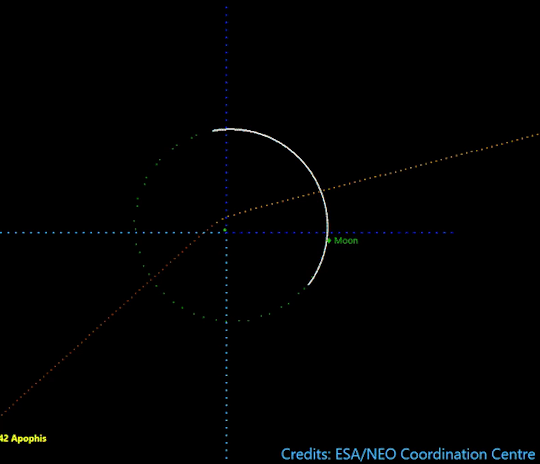
1 note
·
View note
Text
Sonda NASA OSIRIS-APEX retorna com platina de asteroide, estabelecendo marco histórico na mineração espacial
Em um feito sem precedentes que marca o início de uma nova era na exploração espacial e na indústria extrativa, a sonda OSIRIS-APEX da NASA retornou com sucesso à Terra trazendo consigo aproximadamente 800 gramas de metais raros, incluindo platina, extraídos do asteroide Apophis. Missão da sonda OSIRIS-APEX Esta missão histórica, com um custo estimado de US$ 1,2 bilhão, representa um retorno…
#800 gramas#asteroide Apophis#exploração espacial#indústria extrativa#investimento astronômico#metais raros#NASA#Nature Astronomy#platina#sonda OSIRIS-APEX#terra
0 notes
Link
Join us for SpaceTime Series 27 Episode 71, where we delve into the latest cosmic events and technological advancements reshaping our understanding of the universe. First, we discuss NASA's announcement that the Hubble Space Telescope will begin winding back its science programme due to ongoing issues with its gyroscopes. This decision marks a significant transition for the historic observatory, which has revolutionised astronomical discovery since its launch in 1990. Next, we cover the long-awaited launch of Boeing's Starliner, which has finally taken a crew to the International Space Station. This milestone paves the way for Starliner to join SpaceX's Dragon in transporting crews to the orbiting outpost under NASA's commercial crew programme. Finally, we highlight NASA's OSIRIS Apex spacecraft's survival after a close encounter with the sun. This mission is essential for its upcoming rendezvous with the asteroid Apophis in 2029. Follow our cosmic conversations on X @stuartgary, Instagram, YouTube, and Facebook. Join us as we unravel the mysteries of the universe, one episode at a time. Sponsor Offer This episode is proudly supported by NordPass. Secure your digital journey across the cosmos with a password manager you can trust. Find your stellar security solution at https://www.bitesz.com/nordpass. Listen to SpaceTime on your favourite podcast app including Apple Podcasts, Spotify, YouTube Music, or wherever you get your podcasts. Support SpaceTime Become a supporter of SpaceTime: If you'd like to support SpaceTime and access early release episodes, commercial-free...then look for us on Patreon or Supercast. Links on our website at spacetimewithstuart.com https://www.bitesz.com/show/spacetime/support/ www.bitesz.com
#apex#astronomy#boeing#discovery#edwin#failure#gyroscope#hubble#infrared#international#light#nasa#osiris#shuttle#space#spacex#starliner#station#telescope#visible
0 notes
Text
NASAs OSIRIS-APEX Unscathed After Searing Pass of Sun
Mission engineers were confident NASA’s OSIRIS-APEX (Origins, Spectral Interpretation, Resource Identification – Apophis Explorer) spacecraft could weather its closest ever pass of the Sun on Jan. 2, 2024. Their models had predicted that, despite traveling 25 million miles closer to the heat of the Sun than it was originally designed to, OSIRIS-APEX and its components […] from NASA https://ift.tt/3cS9GxJ
0 notes
Text
Ok the fact they're sending a spacecraft named Osiris to an asteroid named Apophis is part of why I love astronomy
0 notes
Text
0 notes
Text
The New Yorker Daily: How Bad Is It?
The White House recently proposed the smallest NASA budget since the dawn of human spaceflight, after adjusting for inflation. We spoke with David W. Brown, who has written about space for the magazine since 2020, and with an official at the European Space Agency.
What does this mean for the future of America’s space program?
The proposal “doesn’t cut to the bone—it just lobs off limbs,” Brown told us. It would axe countless satellites and instruments; decommission solar-system probes that are already under way; and finish OSIRIS-APEX, a program that aims to help protect Earth from a catastrophic asteroid strike.
A Trump Administration press release said that the proposal “accelerates human space exploration of the Moon and Mars,” in part by investing a billion dollars in missions that aim to land astronauts on Mars—a Trump campaign promise and a priority of his former adviser Elon Musk. But next to the astronomical costs of such missions, Brown noted, “That’s like tipping your waiter a dime.”
The proposal has also rattled NASA’s partners. “It’s a disaster,” an E.S.A. official told us. “Basically, if you go through it, it means that there’s no E.S.A.–NASA collaboration left.” Joint projects that Europe has already funded may wither. One U.S.-funded instrument that could be terminated is MODIS, a satellite-based climate sensor that collects, among other information, fire data for the entire world. “We’re really concerned,” the official said. “And we don’t have an alternative.”
Congress could counter with its own budget proposal for the space agency, as it has in past Administrations. But Brown pointed out that some of NASA’s current leaders are already implementing deep staffing cuts that the Trump Administration has ordered. As an engineer at the agency recently texted Brown, “NASA is jumping up to the sword of Damocles before it has a chance to drop.”
19 notes
·
View notes
Text
A valuable second mission and a dramatic rendezvous
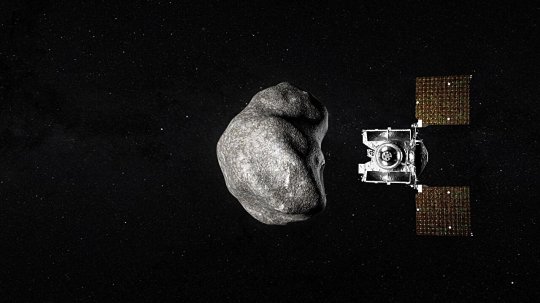
OSIRIS-REx flies on as OSIRIS-APEX to explore its second asteroid
After seven years in space and over 4 billion miles traveled, NASA's OSIRIS-REx mission successfully collected and delivered the first U.S. sample from a near-Earth asteroid. Yet, after all this time and travel, the spacecraft will not retire.
Instead, NASA extended the University of Arizona-led mission so that the spacecraft can be used to study another near-Earth asteroid named Apophis. The mission was renamed OSIRIS-APEX, short for OSIRIS-APophis EXplorer. An overview of the mission was published in The Planetary Science Journal.
OSIRIS-REx deputy principal investigator Dani DellaGiustina is now the principal investigator for the OSIRIS-APEX mission.
Twenty minutes after dropping the sample high above Earth's atmosphere on Sept. 24, the spacecraft fired its thrusters to put it on course to rendezvous with Apophis in 5½ years—just after Apophis makes its own close approach to Earth. This path includes three Earth gravity assists and several nail-bitingly close laps around the sun.
By April 2, 2029, the spacecraft cameras will begin collecting data as it approaches the asteroid. Apophis will also be closely observed by Earth-based telescopes. But in the hours after the close encounter, Apophis will appear too near the sun in the sky to be observed by Earth-based optical telescopes. This means any changes triggered by the close encounter will be best detected by spacecraft.
The spacecraft will catch up to the asteroid on April 13, 2029, as the asteroid whizzes 20,000 miles above Earth's surface. Scientists will then spend the next 18 months studying the asteroid in detail. They'll also disturb the material on the surface with the spacecraft to reveal what lies just beneath.
"Apophis is an infamous asteroid," said DellaGiustina, who is an assistant professor of planetary sciences at the UArizona Lunar and Planetary Laboratory.
"When it was discovered in 2004, there was a scare that it was going to impact the Earth in 2029, but that risk was retired. Then there was another scare that it was going to impact the Earth exactly seven years later, in 2036, but observations combined with modeling now show that Apophis doesn't pose a risk for at least the next one hundred years. Despite this, Apophis still has this role in the psyche of all of us who study these things. While it's not going to impact the Earth in 2029, however, it does get very close."
The 340-meter-wide Apophis is a stony, or S-type, asteroid made of silicate materials and nickel-iron, which are different than C-type asteroids like OSIRIS-REx's first target, Bennu, which are rich in carbonaceous material.
Apophis likely formed from a collision of a parent body in the asteroid belt that knocked it toward Earth's neighborhood. The asteroid will pass closer than some of Earth's orbiting satellites and one-tenth the distance to the moon. This is the closest approach by an asteroid of this size in modern history, and it will be visible to the naked eye in the Eastern Hemisphere.
An asteroid of this size coming so close to Earth is rare, occurring roughly once every 7,500 years.
The mission considered visiting other targets—even Venus—but Apophis was chosen, because it was the only object that the spacecraft could closely rendezvous with, DellaGiustina said. The close approach allows scientists to study interactions with Earth's gravitational forces, specifically tidal forces that could disturb its surface to reveal what lies beneath.
"Apophis gets close enough that there is some amount of activity that we are anticipating on its surface," DellaGiustina said. "There might be landslides or particle ejections that create a comet-like tail. The close approach is a great natural experiment.
"We know that tidal forces and the accumulation of rubble pile material are foundational processes that could play a role in planet formation. They could inform how we got from debris in the early solar system to full-blown planets. Our best guess right now is that Apophis is, indeed, a rubble pile."
Mission science goals are based on what is known about Apophis from ground-based observations, the team's experiences at Bennu and current data for other S-type asteroids. Ultimately, the team hopes to understand the asteroid's evolution and characteristics, including Apophis' material strength, porosity and density. All they learn can inform planetary defense research, especially because most of the potentially hazardous asteroids are also S-type asteroids like Apophis.
"We learned a lot at Bennu, but now we're armed with even more questions," said Amy Simon, OSIRIS-APEX mission project scientist and senior scientist for Planetary Atmospheres Research in the solar system Exploration Division at the NASA Goddard Space Flight Center.
For example, as deputy instrument scientist for the OSIRIS-REx Visible and near-IR Spectrometer, Simon and colleagues detected clay minerals and organics on Bennu, suggesting that the asteroid interacted with water in the past. Scientists predicted finding these on C-type asteroids like Bennu but were unable to detect it from ground-based observations.
Simon said she's excited to see how Apophis looks different from expectations and from carbonaceous asteroids Bennu and Ryugu, which Japan visited with the Hayabusa 2 probe in 2018.
Getting up close and personal with these asteroids presents a unique opportunity for planetary scientists. Currently, scientific understanding of solar system formation is heavily informed by meteorites, which are pieces of other celestial bodies that fall to Earth.
Asteroids are the primary parent bodies of meteorites but are usually observed from so far away that they appear only as points of light in the sky that reveal little about their global properties or surface variability.
The OSIRIS spacecraft science instruments were specifically designed to connect our understanding of meteorites to their parent asteroids by placing meteorite-scale rocks into geologic context on asteroids and investigating asteroids' geologic processes at Bennu and very soon at Apophis.
3 notes
·
View notes
Text
Ikora Week Day 3 - Undefeated
Shed thy self.
When I battled Madhir, he tried the same trick as Azirim. But I simply became someone else. I do not mean that I pretended to be someone else. I mean that I allowed Madhir to change me into someone who Madhir could not tempt.
I laugh much less since that day. But I am more content.
-First Calling of the Hidden, Annotated.
[on AO3] - cw for body horror & language reminiscent of sexual violence
...
The Ahamkara coils down the side of the mountain and through the orange-yellow-blue potholes of the hot springs until it can settle before her. It's in the form of something like a lion, something like a lizard, and yet nothing very much at all like either of those things. Its scales and fur are the same baked alkaline orange as the dirt around the springs; its throat and frills and rows of eyes glow Cherenkov-blue. Aposematism. And yet here she is anyway. She's never been good at listening to warnings.
Her head still hurts from Wei Ning's punch, and the pressure of the Ahamkara's voice only makes it worse. He's borrowed it from Osiris—he must be able to taste the bitter tang of her disappointment in herself for that misstep with Azirim—and he makes it known that his name is Madhir. He asks her what she wants.
Ikora traps the sides of her tongue between her teeth, bites down. Carefully, carefully, she thinks her way around the desire she knows he senses, thoughts averted like she’s looking away from a too-bright light. She knows the shape of it now, after Azirim—can feel the sticky guilt and sorrow in her throat and sidestep it before Madhir can sink his teeth in. Instead she says,
"I wish to be immune."
Madhir recoils, and a shiver passes through him. Not a shiver like a horse twitching its skin to shed a fly; a shiver like a ripple through a pond, his physical form going transiently wrong and revealing it as the lie it is, before he stabilizes.
He coils around her and above her, mouth stretching wider to show more teeth, to make room for more teeth than he had a moment prior. The Ahamkara have been learning from humanity throughout this genocide, reshaping themselves to fit ever more neatly into the grasp of human desires. Flint that knaps itself; intentional evolution happening before her very eyes. A smile is a useful tool for an apex predator that needs consent to feed—convincing, comforting. But this one hasn't learned the trick of it yet. And if she has her way, he never will.
"Do you know what you are asking?"
Osiris's voice, pitched like he's about to share some new discovery, glee like a banked fire.
"Do you understand what you are offering?"
Madhir coils tighter around her. The bioluminescent blue fans along his back are growing longer and fluttering in excitement, kicking a light wind into her face. His fur brushes the back of her neck and head, seeps out the rank hot carnivore smell of him. The claws on all his feet are extending and retracting, cutting deep grooves in the silty mud.
Ikora tilts her head back to stare at him. Her pulse is a rapid thrum, adrenaline tempered by practiced control, the steady anticipation of knowing exactly what corner your opponent is about to round in the Crucible.
Does she understand? She understands well enough. It's her only option. She's played out the scenarios, run the calculations last night while she was meditating beside the field of hot white ash that short hours prior had been Azirim. Azirim who defeated her, Azirim who waltzed right past all the precisely bound and catalogued selfish impulses she had accounted for, Azirim who rummaged through the back corners of her brain and returned with something sick and shining that for all her preparations she had missed. Azirim who proved she didn't, maybe couldn't, truly know herself.
She can't afford to have that happen again. The Vanguard, the City, Humanity itself can't afford to have that happen again.
If she cannot map her weaknesses, cannot suss out the desires lurking in her blind spots, well. A predator designed for the task will serve well enough as dowsing rod and cautery both.
"I understand."
Madhir strikes.
She had expected it to hurt, perhaps, but it just feels strange. His snout sinks into the hollow below her sternum, a tight knot like she's swallowed something too large too fast. She watches with interest— Ahamkara change their shape at will, but presumably some rules of physics must still apply? Her flesh is still there, taking up space, and yet his muzzle overlaps it, and is pushing deeper into her chest as she watches. And earlier too, the way his form had shivered like a reflection distorted by a thrown stone— maybe their shapes are all illusion? Lies made real, or real enough to fool. But then how would their bones-
Madhir starts to chew.
Her breath leaves her with a ragged cut-off cry, wind knocked out of her and replaced with hot red pain. When Ikora can open her eyes against the feeling, she expects gore, a warm soak of blood down her robes, but what she sees is worse.
Madhir's head is buried in her up to his first row of eyes now, which are slitted in pleasure. Her own body is distorting wrong and warped like his had, stretching like her ribs are as malleable as clay, flesh piling up in bloodless ripples to make room for the jaws that gnash and tear at something deep inside her, burrowing deeper still.
The sheer wrongness of it makes her panic. She struggles involuntarily, pure animal impulse of something caught in a trap, but his claws cut grooves into her arms as easily as they had in the clay, and hold her still as he feeds. Sharp carve of fangs through whatever part of her desires shares space with her lungs; hot lap of tongue against what hides between the anterior processes of her vertebrae. A deep, tugging pull that comes with a sensation oddly like walking from one room to another and forgetting what you came there for.
Madhir grows as he feeds, bending her backward in his grip as he shoves his head deeper into her ribcage, nosing around like a scavenger for the choicest scraps of organ meat. He grows enough that her feet come off the ground and her whole weight hangs from the blades of his claws. There is a hot wash of liquid down her front by now, but it isn't blood—Madhir is a messy eater, and he slavers at the feast she is giving him.
Ikora can glimpse the edges of what he's tearing out of her, a flicker-fast parade of weaknesses.
The guilty hum of the wish near-fulfilled by Azirim.
A cavalcade of wants that all sparkle bitter with the metallic scent of radiolaria and the sweet burn of incense.
Resentment at the duties she's been saddled with, that he left her with; The Last City at night, a weary need to be strong enough to bear the weight of all those lives.
The skittish, selfish want to not bear it at all: gunpowder clash of the Crucible, scent of pine trees from her first fumbling runs at scholarly suicide, long before she'd even heard the term thanatonaut.
The warm press of Chalco's arm around her shoulder; the flash of Eris's smile at a campfire.
A hundred, a thousand other wants, torn out at the root and devoured one by one, leaving raw hollows in their wake.
Once he's sated, once he has gorged himself on the rich meat of everything she's ever wanted and licked her clean of the crumbs of her smaller, simpler impulses, he drops her unceremoniously to the ground.
She crumples.
The slices from his claws bleed sluggishly as Ikora slowly drags herself back up to standing. A strange sensation, to stand without wanting it; stranger still to look at Madhir and feel nothing. Ikora can remember the riot of everything she wanted earlier: the desperate desire to not fail in her hunt, the hope her ploy would work, the wish to never again be understood without her consent like she had been by Azirim, but it's all gone. She looks at him now, licking his lips and basking like a lion after a kill, and feels nothing but a slight distaste.
A chill whisper of voidlight spins up between her fingers. She doesn't need to want his execution to know it needs to happen.
...
She stacks his bones and burns them to charcoal, and then to ash that mixes with the clear water of the hot springs until they're choked with fine gray paste.
She doesn't hear a single whisper.
#ikoraweek2024#crossposting smth i wrote shortly before ikora week was announced#or i would have held onto it oops#anyway. heavily inspired by dunmeshi bc good god. the ahamkara could learn from that.#mine#ikora rey#my fic#destiny fanfiction#i love her. 'i laugh less since that day' yeah??? you were so scared to have a desire you couldnt control that you let a dragon#EAT YOUR FEELINGS. AND CONSIDERED IT A VICTORY.#there is something sooo wrong with you babygirl <3
15 notes
·
View notes
Text
Apophis Impact more likely than NASA thought! The case of 2024 MK!
youtube
The asteroid named Apophis is probably Wormwood from the 7 year tribulation period of Revelation (God's wrath). Named after an evil serpent demon of chaos & disorder, by NASA, in 2004. Discovered by Kitt Peak National Observatory 1500 ft wide (450 meters) & 550 ft tall (170 meters) 4 NFL football fields. Traveling 28,000 MPH. It's 20 million metric tons or 40 billion pounds in weight. The explosion will equal 880 million tons of TNT. That's 65,000 times more powerful than Hiroshima nuclear explosion. Revelation 8:10-12 & Luke 21:25-28 The third angel blew his trumpet, and a great star fell from heaven, blazing like a torch, and it fell on a third of the rivers and on the springs of water. The name of the star is Wormwood. A third of the waters became wormwood, and many people died from the water, because it had been made bitter. (It will poison 1/3 of the water.) It should be visible by telescope in 2025. It should be visible with naked eye in 2027. It should hit California & Mexico border in April, on Friday the 13th, in 2029. The information is from Tom Horn (he got a vision from God & realized that the asteroid named Apophis matched the vision) on Sid Roth TV show. The Apophis asteroid is on Wikipedia. The video is on YouTube. Study Bible eschatology.
They say Apophis was discovered on June 19, 2004 (possibly more likely around 1994). They originally said that Apophis would hit Southern California on April 13, 2029. That's 25-35 years between discovery & possible impact. Then they changed their statement to say that it would miss Earth on that date, by 20,000 miles. I think that they're lying, like the government in the movie, "Don't Look Up." Here are some movies showing predictive programming of an asteroid hitting Earth.The Deep Impact movie was released on May 8, 1998. The Armegeddon movie was released on June 30, 1998. Touched by an angel Season 9 Episode 1 is an asteroid similar to Apophis. Aired September 28, 2002. Meteor Apocalypse released in February 23, 2010. Quantum Apocalypse released on February 24, 2010. The movie Seeking a Friend for the End of the World was released on June 22, 2012. The movie Greenland was released on July, 20, 2020. The movie Don't Look Up was released on December 10, 2021. The movie Mira was released on December 22, 2022.
NASA lied about the moon landing, too. NASA stands for Never A Straight Answer & Not A Space Agency. Watch Antichrist45 on YouTube or Rumble or Antichrist45.com. The rapture & Antichrist are close. The tribulation period starts when Donald Trump finishes the Abraham Accords like in Daniel & Revelation. It will be 7 years of God's wrath. Jesus Christ saves us from the wrath. Look up the Hosea prophecy & Fig Tree Prophecy. Please watch Don't Look Up again. I believe the movie is revealing a lot of truth. It appears to mimic President Trump & Elon Musk, the comet hits near San Diego just like NASA originally said the Apophis/Wormwood asteroid would hit, the morning talk show has RIP (rest in peace) all over the show (it's on their cups). NASA says their sending Osiris Apex to collect specimens from Apophis in April 2029. Osiris is an Egyptian god (fallen angel) often portrayed with his arms crossed in the shape of an X. He was resurrected in Egyptian mythology. I believe that represents the Antichrist after he gets possessed by Satan after receiving a deadly wound, then he comes back to life & demands worldwide worship & the Image & Mark of the Beast. I believe that the satanic Illuminati often pose with their arms crossed to show their allegiance to the Antichrist & satan. The Antichrist looses his right eye. That's why the Illuminati members cover one eye. To show allegiance to the Antichrist & satan. Elon plans to send humans to Mars from 2029-2031. He's trying to escape with Trump, like at the end of Don't Look Up. Trust the Holy Bible. The tribulation is very likely 2026/27 - 2032/33. The rapture is very likely by 2028.
Please study & share this on social media & with your friends & family. 🙏
3 notes
·
View notes
Text

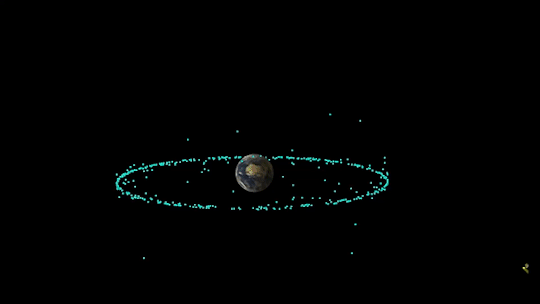
Fresh off its historic mission to collect samples from an asteroid in deep space, NASA's OSIRIS-REx spacecraft has its newest assignment: studying another asteroid during its close encounter with Earth.
OSIRIS-REx ended its seven-year, 4 billion-mile round-trip journey to collect samples from the space rock Bennu in September. But instead of shutting down the craft, the team proposed sending it on a second mission to the asteroid Apophis, expected to pass closer to Earth in 2029 than any other similarly-sized asteroid in recorded history.
They're renaming the spacecraft OSIRIS-APEX (Origins, Spectral Interpretation, Resource Identification, and Security – Apophis Explorer).
"The close approach is a great natural experiment," Dani Mendoza DellaGiustina, principal investigator for OSIRIS-APEX, said in a NASA press release last week. "We know that tidal forces and the accumulation of rubble pile material are foundational processes that could play a role in planet formation. They could inform how we got from debris in the early solar system to full-blown planets."
Apophis is a more than 1,000-foot-wide space rock named for an Egyptian deity and nicknamed the "God of Chaos."
The asteroid, first discovered in 2004, is expected to pass within 20,000 miles of Earth's surface — nearer than some satellites — on April 13, 2029. _________________
I got super excited for a extinction level event for a moment there
22 notes
·
View notes
Photo

NASA has more than twice the asteroid Bennu samples it could have hoped for from OSIRIS-REx probe | Space
The once inaccessible sample container has been fully opened, and NASA has released the numbers
We now know exactly how much material OSIRIS-REx captured from its target asteroid Bennu — and, it's a lot.
In addition to the 2.48 ounces (70.3 grams) of sample already collected from the outside of the canister, NASA has finally managed to fully open OSIRIS-REx's sample container to find another 1.81 ounces (51.2 grams) of asteroid Bennu within. In all, the probe collected more than twice what scientists had hoped for.
OSIRIS-REx completed its asteroid sample return mission when the probe parachuted a tightly-sealed container back to Earth on Sep. 24 before embarking on a secondary mission dubbed OSIRIS-APEX, named for its next space rock target, the asteroid Apophis.
With this container came the first pieces of an asteroid NASA has ever captured and returned for further study. The mission launched in 2016, and the safe recovery of the capsule last year was the ceremonious end to an epic seven-year journey through space. However, once NASA technicians got a hold of the sample container, they stumbled upon some complications — it was too difficult to open. ...
3 notes
·
View notes